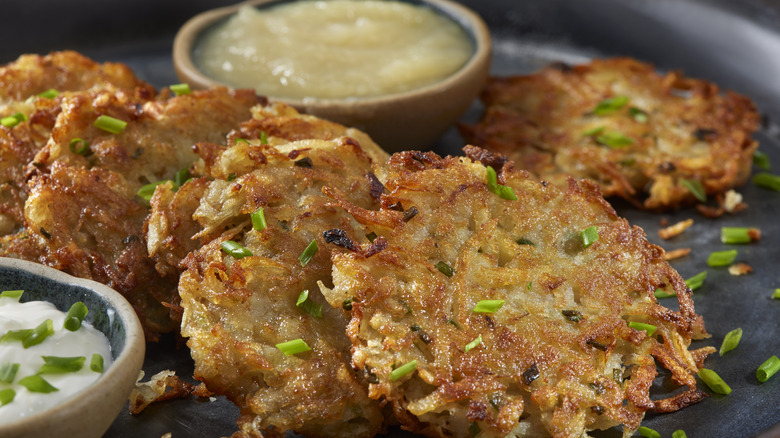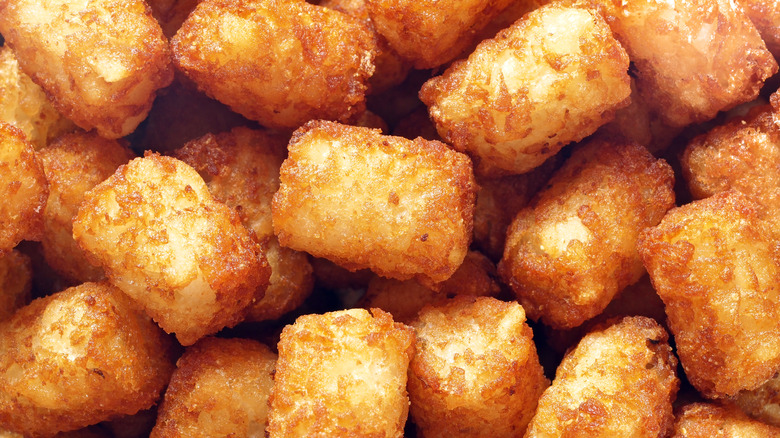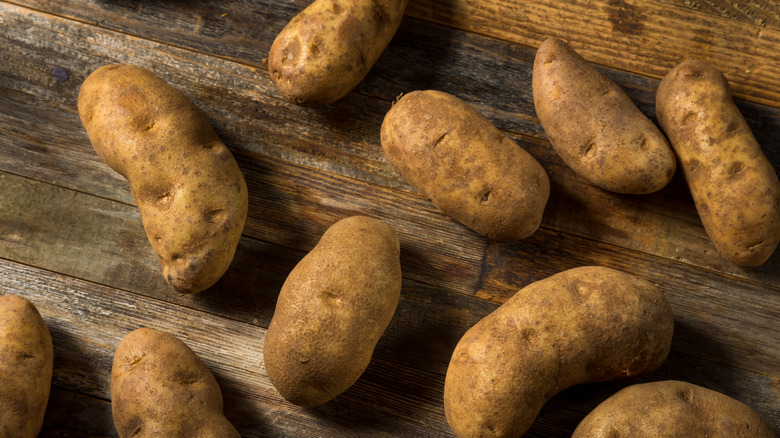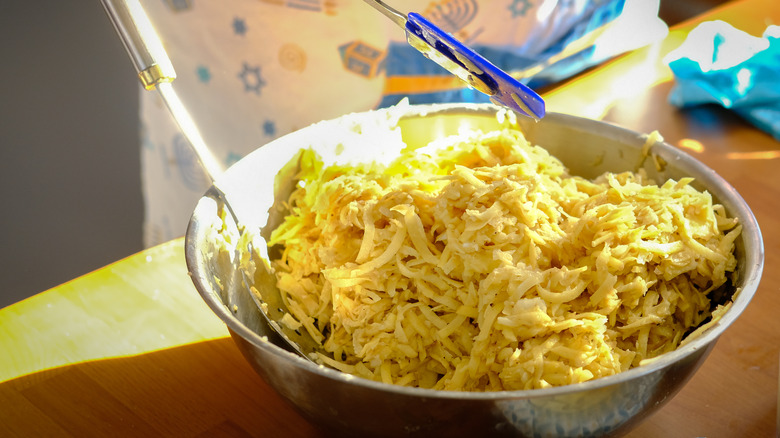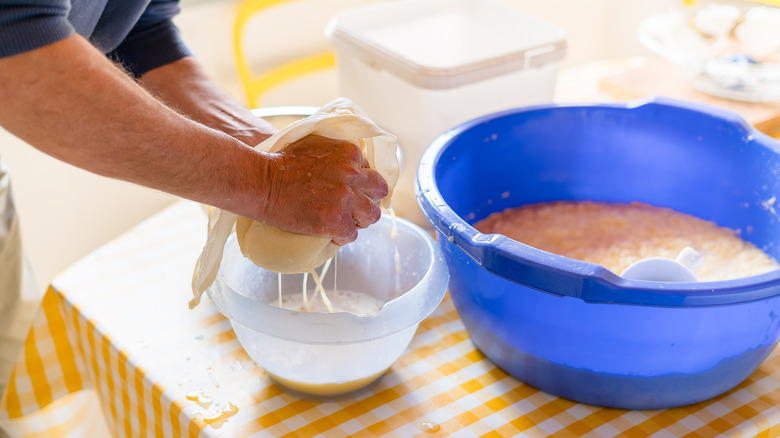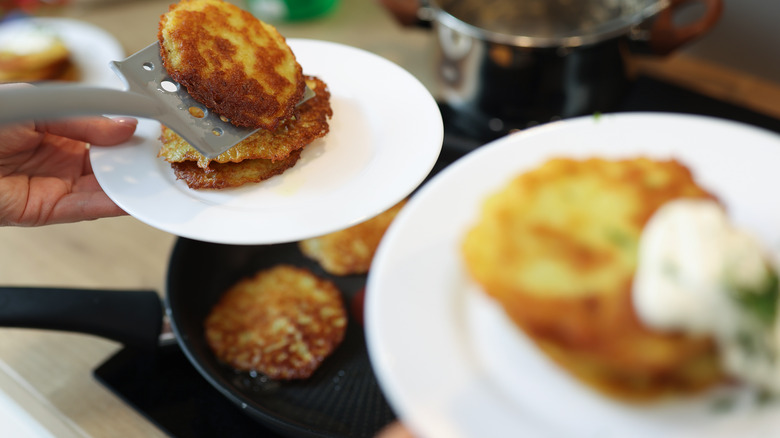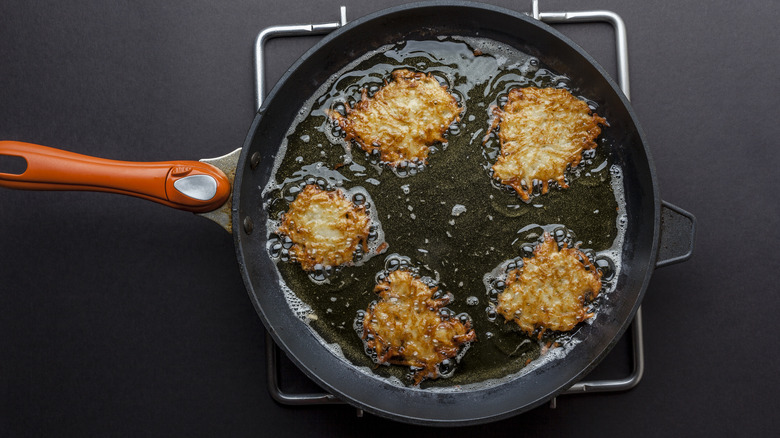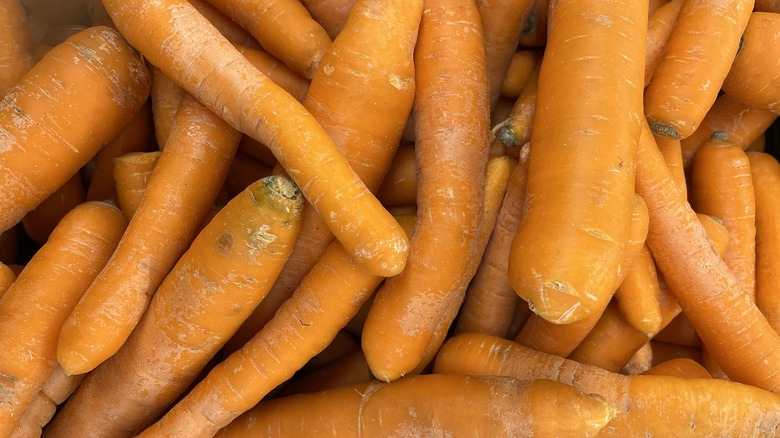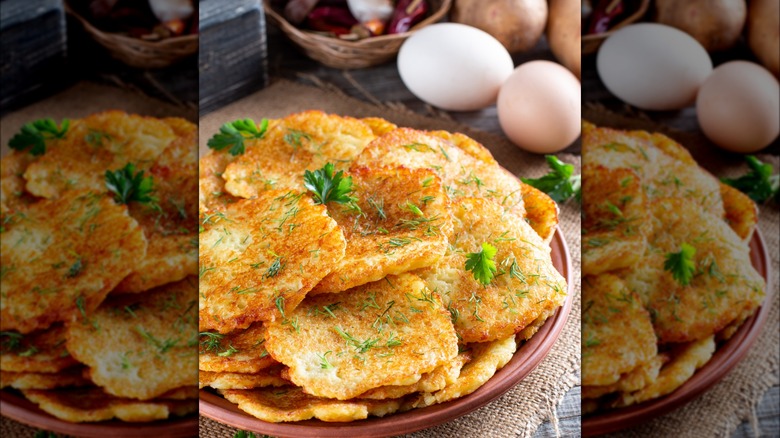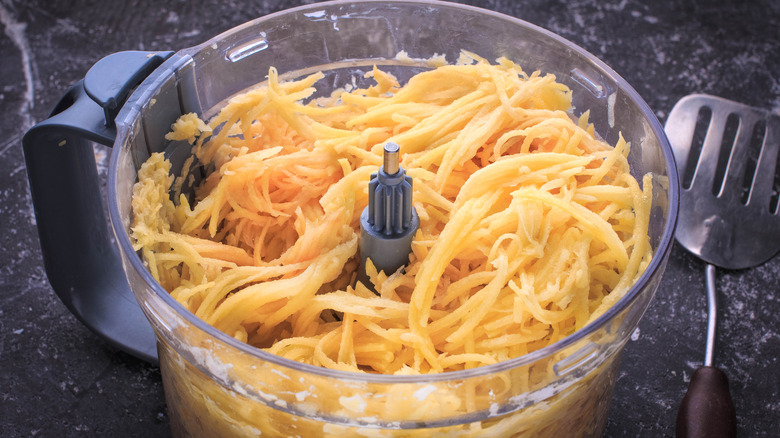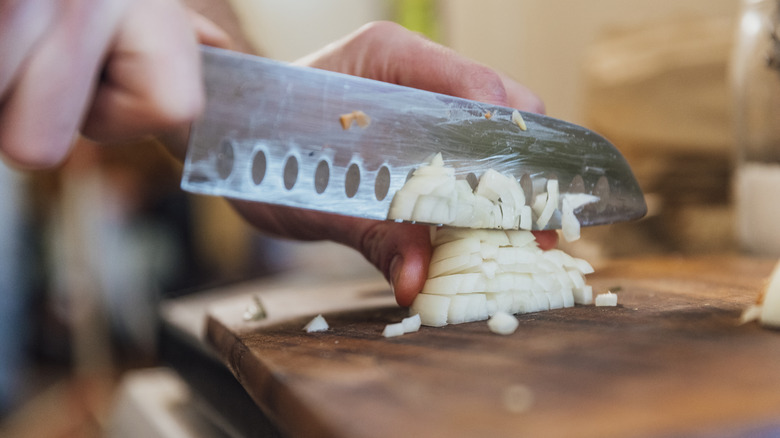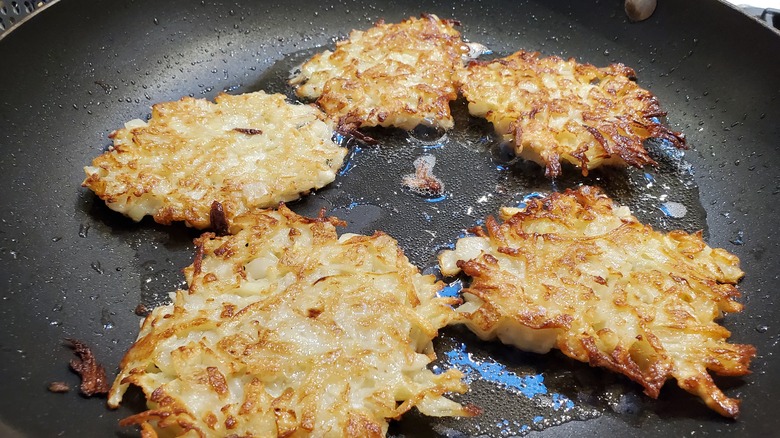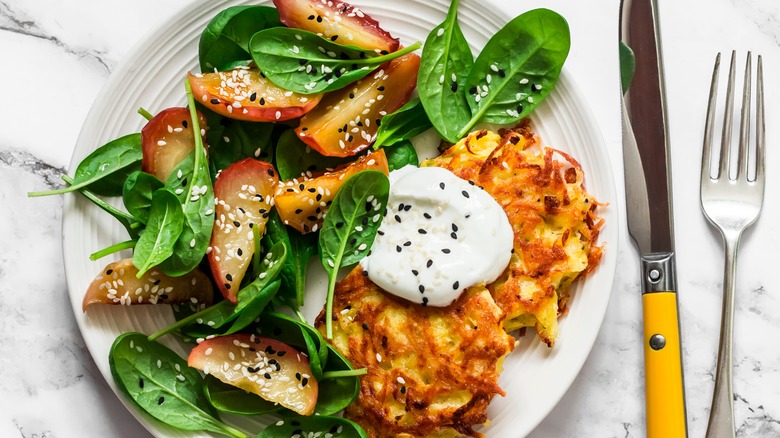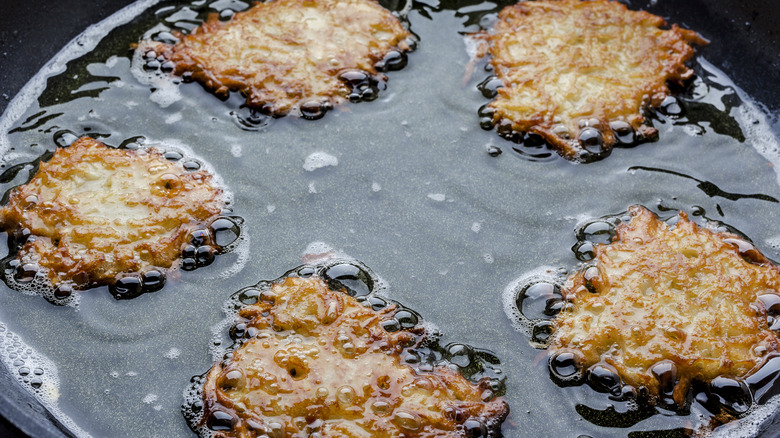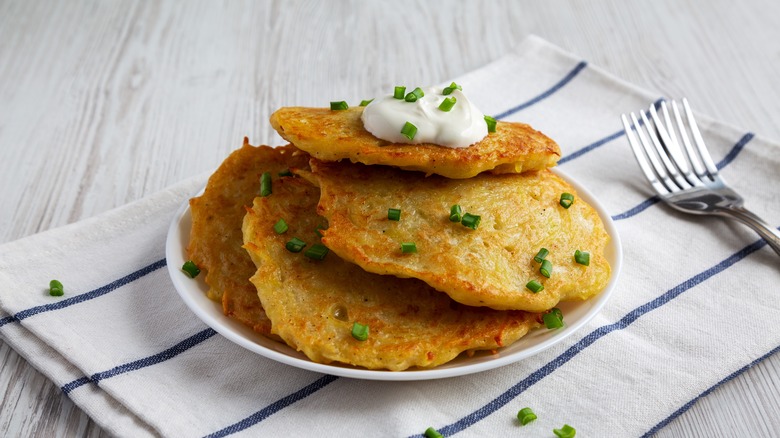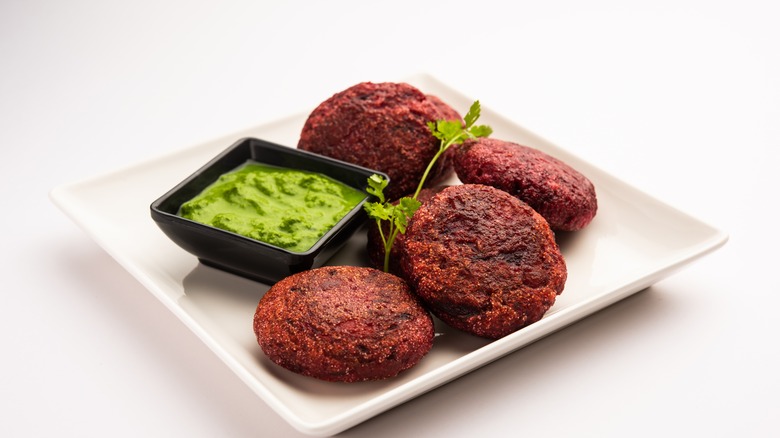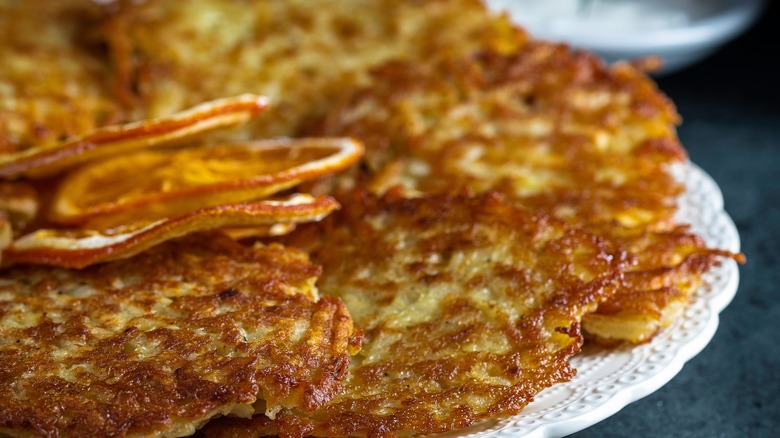16 Tips You Need To Make The Best Potato Pancakes
There's a lot to love about potato pancakes. You might have heard the term used interchangeably with latke; after all, both share a crunchy, fried exterior and soft, chewy potato interior. However, there are some significant differences between potato pancakes and latkes. The latke was a historically Jewish food brought into the Hanukkah tradition, while the potato pancake was first believed to derive from Germany. The potato pancake also has a shorter ingredient list — grated potato, egg, and flour — while the latke typically has a more extensive makeup, including baking powder, matzo meal, and occasionally milk.
Besides these differences, the potato pancake and the latke are prepared and cooked similarly — which is why our tips for making delicious potato pancakes are largely applicable to latkes, too. Here are some of the ways you can make delightful potato pancakes at home, whether you're eating them for Hanukkah, Christmas Eve, or just as an appetizer with the staple side of applesauce or sour cream.
Take the easy way out with smashed tater tots
Potato pancakes are not exactly a difficult food to make, but there will always be an easier way out than making them yourself. The frozen potato shortcut for delightful mini latkes is perfect for serving as a side dish or an appetizer at your next gathering.
Start by using a tater tot brand that contains both potato and onion, such as the Ore-Ida, because it will have a flavor more similar to the traditional latke. From there, par-cook the tater tots in an air fryer or conventional oven. This will make the tiny taters easier to smash into pieces. Once the tater tots are soft but not fully cooked, crush them with a flat glass until they resemble small, round discs. You can either continue cooking the tater tots in the air fryer or shallow-fry in a skillet with neutral oil for a crispy, latke-like exterior.
Use Russet potatoes
With the sheer number of potato varieties at the grocery store, how do you decide which one is best for making potato pancakes? Russets are the type of potato you should use for latkes, but you can also settle for Yukon gold in a pinch. The Russet has a high starch content, which makes it easier for the flecks of the potato to stick together and keep their shape rather than breaking and disintegrating into the hot oil. Another quality of the Russet is that it is relatively low in water, so you won't have to take extreme measures — besides wringing it out with a towel — to prepare your potato hash for frying.
The types of potatoes you'll need to avoid include waxy red potatoes. They're notoriously wet and gum up when cooked; it's why most people avoid them for recipes that involve frying or mashing.
Prevent oxidation with an acid
One of the most common issues people come to when cooking potato pancakes is that the potatoes oxidize relatively quickly. This oxidation causes unsightly browning and discoloration, which doesn't make for a very appetizing side dish. To get the best color for your latkes, you'll want to avoid cutting up your potatoes prematurely and try a couple of simple remedies to minimize browning.
Once your potatoes are shredded, add them to a bowl with water with a couple of drops of acid — like lemon juice or distilled white vinegar. Ice water is ideal for this method because it promotes a beautiful golden-brown hue after the potatoes are fried. Once you're ready to fry up your spuds, drain out the water and squeeze as much moisture out of the potatoes. You'll be on your way to potato pancakes that are as delicious to the eyes as they are to the stomach in no time.
Always wring out your potatoes
You won't want to miss this critical step when making potato pancakes or classic latkes. It's imperative to wring out your potatoes (and onions if you're making latkes) before mixing the rest of your ingredients. To do this, place all your vegetables in a clean kitchen towel, grabbing the ends, and twisting into a ball until the water leaks. If you neglect to wring the water out, your latkes won't crisp up and will likely fall apart during shaping and frying.
Using a thinner towel is ideal for maximum drainage, so cheesecloth is preferable. Consider wringing out the potatoes and the onions at least twice before moving on to the next stage of the recipe. For best results, try working in small batches; the perfect shreds are dry to the touch. Some recipes will recommend saving the starchy water to add back to the shreds to help bind them together, but this creates more issues with moisture.
Think small when scooping potato pancakes
One of the biggest mistakes people make when scooping their latkes is making them far too big. Great potato pancakes are supposed to be crisp and fried rather than dense and soggy. In turn, adding too much batter to your latkes will cause them to remain raw in the center while browning too much on the outside. Bringing down the temperature of the oil to moderate this effect will only cause your latkes to get soggy and greasy.
When you're shaping your potato pancakes, aim for between ¼ and ⅓ cups of batter for each pancake. This size is perfect for appetizer-style latkes. Once you place the patties in the pan, it's also essential to give each of them their space and avoid overcrowding. Not only will this lower the oil temperature more quickly, but it won't create the lacy appearance that potato pancakes are known for.
Pick the right skillet
Picking a suitable skillet is the key to good potato pancakes. You'll want to look for a heavy skillet that can withstand high temperatures, such as cast iron, carbon steel, or copper-bottomed pans. If you want to prevent a lot of splatter from the pan, you can also opt to use a Dutch oven with high sides. Avoid non-stick cookware, which is flimsy and unsuited for high-heat cooking.
Is a skillet the only way to cook potato pancakes? If your alternative guess was in an air fryer, you'd be correct. Place the patties on an oiled piece of parchment paper at the bottom of the air fryer. After brushing the top of the patties with oil, cook at 400 F for about ten minutes on each side. You won't have to worry about the oil splatter or the lingering smell of cooking oil in your kitchen.
Try the carrot trick
Another root vegetable, other than potatoes and onions, can help you make the best potato pancakes. The carrot trick to help you fry perfect latkes involves putting a few 2-inch carrot pieces in the hot oil with the latkes. The raw, untrimmed carrot will pull all of the small potato and onion pieces that would otherwise burn and alter the flavor of the oil. When using this trick, it's important always to add the carrots to the oil as you're adding the potato pancakes. This will ensure the carrots don't burn before the latkes cook. You may also need to keep a few fresh pieces of carrot nearby to swap out to ensure this hack works.
You may be wondering about the science behind this hack. Carrots have a high water concentration, which allows the vegetable to buffer the heat of the oil.
Don't neglect your binder
The only ingredient more important than potatoes in latkes is the binders. This class of ingredients, which can include eggs, matzo meal, and flour, helps hold the patty together. Without it, your potato pancakes would look more like breakfast hash.
The jury is still out on which binder reigns supreme. Some people prefer using matzo meal, a breadcrumb made from crumbled matzo, instead of flour because it doesn't make the pancakes as dense but still soaks up the leftover moisture from the potatoes and onions. Other folks recommend using egg whites versus whole eggs because it promotes crispiness when the latke is reheated in the oven. Cornstarch is one ingredient we've experienced a lot of success with in making potato pancakes. Not only does it make the recipe gluten-free, but the cornstarch soaks up all the liquid and binds the ingredients together. We've even been able to omit the eggs for a vegan version of the recipe when cornstarch is used.
Use a food processor instead of a box grater
The texture and size of your potatoes matter when it comes to making latkes. We recommend using a trusty food processor instead of a boxed grater to shred your potatoes. This is because the boxed grater produces flimsy potato shreds that form clumps rather than a hash-like texture. When outfitted with a shredding blade, the food processor makes pieces that resemble firm match-sticks, thus, are less weighty than grated potatoes. Other benefits of using a food processor include potatoes that are shredded in a fraction of the time, as well as hands that are protected from the sharp sides of a box grater.
If you are a latke-traditionalist and only want to use a box grater, you should always use the largest hole setting on the kitchen tool. This will ensure your potato specks come out largely intact rather than mushy.
Use onion chunks rather than grated onions
We unequivocally recommend adding onions to your savory latkes. It just makes the flavor of the pancake sharper, plus the little caramelized onion pieces are slightly sweet and just make the food more complex. Before you grate your onions into the mixture with the potatoes, you should think twice about the shape and texture you desire.
Grated onions are not ideal for latkes. This is because onions tend to release more water when they are ground into a pulp, which means that you risk making your pancakes too watery. Plus, the onion flavor tends to overwhelm the potatoes since the cells of the onions are more readily ruptured when the allium is grated. Instead of grating your onions into the batter, we recommend roughly chopping them instead. These larger pieces will have a sweet flavor that balances with the comparative blandness of the potatoes, plus your patties will brown more evenly in the pan.
Make a tester before frying the whole batch
One of the biggest mistakes any cook makes, not just for potato pancakes, is getting too far ahead of themselves. You get so excited to cook that you forget to stop along and smell (or, in this case, taste) the batter. It's the only way to determine if your ratios are right and if you've added enough seasoning to your pancakes.
You should always plan to add salt to your latke batter right before you fry it. Otherwise, you risk causing a coleslaw effect and making the batter too watery. You should also plan to add a fair amount to your mixture and test once (or twice) before finishing up your recipe. Your tester batch will also determine if your frying oil is hot enough and if you need to add more egg, flour, or matzo meal to keep the pancake together.
Get creative with your toppings
The most standard toppings for latkes include applesauce and sour cream, but these aren't the only toppings that will elevate the flavor of your potato pancake from boring to extraordinary. We always recommend making your own applesauce for the latkes. That way, you can experiment with flavors, like making a pear-apple sauce seasoned with sharp star anise. If you want to make your latkes the talk of the town, consider serving them with sophisticated toppings like lox, cream cheese, sliced cucumber, or crispy bacon (or the Kosher alternative, turkey bacon).
Potato pancakes also aren't only for holidays. You can make these sides with roast chicken, beef, or pork chops — which aren't Kosher but pair well with applesauce. The main topping you'll want to avoid for potato pancakes is, of course, ketchup, which might be a pairing for other fried potato products — but will transform this unique potato dish into a mere hash brown.
Fry hot and be mindful of your temperatures
If you've spent a ton of time crafting, mixing, and shaping your latkes, don't throw it all away during the frying step. Before a single shred of potato touches that oil, it needs to be super hot — and the right type of oil. You should always use a neutral oil with a high smoke point, such as vegetable or canola oil, to fry your patties in. This will ensure that the oil won't impart any burnt flavor notes when the latkes are cooking. You'll also need enough oil to shallow-fry your latkes — meaning that each patty should be half-submerged in the oil. Otherwise, you risk parts of the latke sticking to the pan or not cooking enough.
Your oil temperature should be around 375 degrees F for frying. It's important to note that adding more latkes to the pan will bring down the temperature of the oil, so stick to two or three at a time. Once the latkes hit the oil, avoid touching and prodding the patties.
Try making the Irish version with mashed potatoes
Irish potato cakes are one of the most globally-recognized types of potato pancakes. Unlike latkes and traditional varieties, these Irish potato cakes use mashed potatoes as the base for the filling. This recipe is a great way to utilize cold, leftover mashed potatoes straight from the fridge. Hello, upgraded Thanksgiving leftovers! Once the mashed spuds are mixed together with egg, butter, and flour, they can be seasoned with ingredients like chives, chopped bacon, or cheese. Then, the cakes are shallow-fried in butter until crispy on the outside.
The Irish also make boxty — a potato pancake that goes with everything. It's made of both mashed potatoes and shreds, which adds a bit more texture to this breakfast staple. Boxy is often served with breakfast meats, fried eggs, lamb chops, and Irish beef stew. There's no limit to what this preparation of the potato pancake can pair with.
Incorporate other vegetables into your potato pancakes
Potatoes don't have to be the only vegetable you add to your dish. Beets are one of the best vegetables to add to potato pancakes because they'll give each patty a distinct purple hue without detracting from the flavor of the onion or the potato. Combine equal parts beet and shredded potato in your mixture with the other standard pancake ingredients. We recommend topping these pancakes with smoked trout, chives, and crème fraîche.
You can also substitute potatoes for other root vegetables like turnips and rutabaga. Both of these veggies have a neutral flavor profile and can easily be fried just like a standard Russet. This is a great substitute to make when your garden is full of unique veggies, or you're interested in trying a new twist with the produce in your community-supported agriculture (CSA) box. You can also get creative with your sauces, toppings, and mix-ins to experiment with these ingredients.
Use your oven to keep your latkes warm
If you're making latkes, you should plan to be laboring over your stove for quite a while. Once you fry each latke patty, remove it from the pan and place it on a towel-lined plate to soak up the residual oil. From there, eat the latke immediately or transfer the latkes to a warmed oven. A low-temp oven (around 200 degrees F) will keep your latkes warm while you're finishing up frying the rest of the batch.
Like other fried foods, latkes tend not to be the best on the second day. However, there are some ways that you can extend the life of the potato pancake. After cooking and cooling the latkes, you can cover them with plastic wrap and transfer them into the freezer. When you go to reheat the latkes, be sure to keep them in a single layer to prevent them from fusing together. Crisp the pancakes up in your oven when you're ready to eat.
